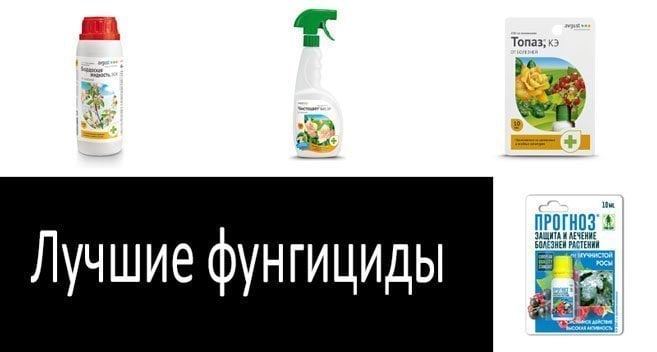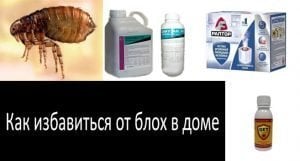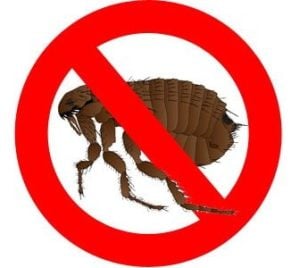Today, hundreds of fungicides are sold in stores that kill harmful fungus on plants, as well as protect them from the most terrible diseases.
{code 568}
Too many factors go into choosing the right fungicide for a given application. The type and age of the plant, the type of disease and its “neglect”. Even the weather, the area of green spaces and the presence of pets in the vicinity play a role. It’s easy to get confused.
We do not recommend buying a fungicide at random: the advertised chemical may turn out to be a “dummy”. It is possible that he is even capable of harming a diseased plant. The best thing is to trust the opinions of professionals.
In our manual, we have collected the recommendations of scientists and the advice of experienced farmers. We deliberately put a review of the most effective fungicides at the very end of the material, because in order to cure a plant, you first need to make a correct diagnosis. And in order to make a correct diagnosis, you need to know everything about plant pests. This is what most of our guide is devoted to.
You need to defeat the fungus wisely!
Content:
- Why is the fungus dangerous for plants?
- What are fungicides?
- Best store bought fungicides
- Comparative table of fungicides
- Fungicides to get rid of powdery mildew
- Fungicides for the treatment of fungus on the lawn
- Fungicides for the treatment of snow mold
Why is the fungus dangerous for plants?
All fungicides have a common enemy – pathogenic fungi, which so easily infect ornamental and agricultural plants. Farmers and housewives, food producers and gardeners suffer from them.
Here’s what fungal spores and fungi themselves are capable of:
- – They disfigure plants: various diseases are reflected in the color and shape of fruits, leaves and flowers;
- – Mushrooms deprive us of the harvest. In just a couple of weeks, they can cause damage to plantings of potatoes, apples, grapes and wheat, tomatoes and cucumbers, blueberries and strawberries;
- – They kill them. Your favorite lawn or home flower may die if not treated in time with the right fungicide;
- – Fungal diseases hit the pockets of farmers and the state. In some cases, the degree of crop loss from the fungus becomes catastrophic, up to ruin.
It is very difficult to avoid infection with a fungus without preventive measures. Spores live in soil, air, on other plants and in water. They are carried by the wind, animals and even people! And then mycelium comes into play: thin threads, something like a mycelium. They penetrate the tissues of the plant and begin to devour living matter. In addition, fungus-covered leaves do not receive light and die without the possibility of photosynthesis.
The most common fungal plant diseases
The presence of a fungus in a plant is most often indicated by external symptoms. White bloom and rusty pads, colored spots and sores, fragments of rot and bumpy growths may appear on the greens. In addition, plants wither from fungi, deform, dry out, become thinner, grow tumors and cease to bear fruit. In the case of lawn and grass, bald spots form on the ground. Any of these symptoms are caused by dozens of different types of fungus. This system is not easy to streamline, but still the most common diseases have received their folk and scientific names. Here are some of them.

Powdery mildew. This is a universal villain that affects the leaves, fruits, stems and flowers of plants. White plaque (mycelium) in a couple of days can completely tighten a garden rose or vine. The disease kills the fruits the longest: they rot and crack. Especially loves “powdery mildew” young shoots. Pumpkins, peaches, gooseberries, cereals, roses, even sugar beets… who doesn’t suffer from it!
Snow mold. This is the enemy of all lovers of natural lawns and tall grass. “Snow mold” usually appears in early spring, after the snow melts. It spreads in circles 3-12 inches in diameter. When these circles “breed”, the lawn can completely die. First, pink, white or gray mold will cover the lawn … then the mushrooms will draw all the juices out of the grass, and it will die. Most often, meadow and reed fescue, perennial ryegrass and meadow bluegrass suffer from this fungus.
Root rot. These diseases like rhizoctoniosis and “black rot” are dangerous for most plants. Fungi undermine the roots of room and garden greenery. You will not know about this for a long time: you will simply follow the smooth withering of the plant. An insidious disease will turn the root system into black dust or rusty dry lashes.
“Spotted” fungus on the leaves. A disease affecting vegetables. Oily dark spots form on the leaves. Most often they suffer from tomatoes and peppers, potatoes, asparagus, rhubarb. This “beauty” directly affects the yield of vegetables. Although the fruits themselves rarely suffer.
And there are also various fungi that affect the grass. It may become covered with rust-colored blisters and red-brown rings (Fusarium disease). The lawn may turn brown and disappear under small cotton clouds (Pythium’s disease).
Prevention of fungal diseases
Fungi love high humidity, stagnant weather, and proximity to other plants. Therefore, it is necessary to observe a certain interval between plantings, as well as save them from excessive watering and poor air circulation. These rules are especially relevant for greenhouse plants. You need to regularly monitor the cleanliness of the soil and dispose of dying plantations.
American scientists who have studied this issue are asking everyone to be careful with mulching and pruning plants (mistakes during these operations can lead to infection). They also call the best way to prevent … the purchase of specially bred varieties that are resistant to fungi. Sterile pots will protect the roots from fungi, control over the purchased soil mixture is a competent irrigation system that excludes stagnant water.

If you notice a fungus on a separate tree and bush, it is important to remove it in time. Professional gardener Mary Bernard believes that cutting off branches and leaves should be avoided when removing infected tissue, because any wound will become an “open gate” for new parasites. It is better to gently cut off the leaves, petioles and bark. She also advises avoiding overhead watering, which spreads spores and makes the leaf more vulnerable. Moisture is better to pour immediately under the root.
The expert calls sulfur, copper, fungicidal soap the best organic fungicides for prevention. However, all these are not the strongest means, so their application must be repeated regularly, Mary Bernard is sure.
What are fungicides?
The classification of fungicides divides them according to the purpose of application. It looks like this.
- protective fungicides. Organic and inorganic agents for the prevention of fungal diseases.
- Therapeutic fungicides. Drugs that can stop the development of the disease and even destroy it.
- Systemic or complex fungicides. They work both for prevention and for the treatment of plants.
- Immunization agents. They improve the metabolism of the plant and teach it to fight not only fungi, but also bacterial diseases.
The principle of action of chemicals also differs. There are, for example, contact fungicides. Most often, these are protective agents that “defend” only that part of the plant on which they are located from fungi. Among farmers and experienced gardeners, “treaters” are popular. They process seeds and bulbs so that in adulthood they are not disturbed by pests.
Recently, organic liquid products that move freely through the vascular system of the plant have become fashionable. They can save individual shoots of an already infected plant from diseases, work as a protective and therapeutic agent .
So what do all these fungicides do to parasites? Some stop their growth and reproduction. Others block enzymes and cellular respiration. Still others do not allow the synthesis of protein and lipids for cell membranes. And some draw out all the liquid from the parasite, and with it, life.
Which is better: organic or inorganic fungicides?
First, it is important to decide whether you are looking for an organic or inorganic fungicide. The former are considered more environmentally friendly and safer for nature and humans. But we are more interested in the practical side of the matter. Moreover, many “organic products” are also synthesized using chemicals.
The advantage of organic fungicides over inorganic ones is that they do not contain rare and hazardous metals. These metals pose a danger to animals, earthworms and, in rare cases, soil. In case too much copper or mercury accumulates. But “natural remedies” decompose underground by themselves, this happens very quickly. True, this property also affects the duration of the healing effect (synthetic chemicals last longer).
Organics are easier to “cook”: most often you just need to mix a powder or liquid agent in water. We add that organics can be combined with a greater number of pesticides than inorganic preparations.
The advantage of inorganic means is consumer confidence. It was the products based on copper, sulfur, mercury and chlorine that were the first to appear on the market: our grandfathers used them. And this is already a certain habit and tradition. Although, logically, younger synthetic organics should be more perfect. But even here it is not so simple. In some diseases, old preparations of copper oxychloride with a concentration of 0.5-0.75% are still not inferior in effectiveness to fashionable synthetic drugs.

Are chemical fungicides so terrible? The USA environment agency writes: “Some of the worst pesticide poisonings occur due to the misuse of organic mercury or hexachlorobenzene to treat inoculum. However, most fungicides in use and registered for use in the US are not capable of causing frequent or severe poisoning.”
So you can harm yourself and the environment only if you use products that are not according to the instructions! The portal asks to be especially careful with these substances: triazoles, mercury, thiocarbamates, dithiocarbamates, mercury.
Best store bought fungicides
Experts have approved dozens of different fungicides, and it’s easy to get lost in this long list of names. Therefore, we decided to help you and selected the most effective tools that can be purchased on the Internet.
Fungicide BORDEAUX LIQUID
A classic fungicide based on copper. Suitable for flowers, fruits and vegetables. It copes well with powdery mildew, black spots and “early” fungi. It must be mixed with water in the proportions indicated on the package and used as a spray. Buyers write that one spray per month is usually enough. But with frequent rains and irregular watering, the product is used more often.
There are several references to the effective use of lawn fungus. In total, about 85% of buyers call the product useful.
Price: 499 rubles.
{code 569}
Fungicide CLEAR COLOR
A similar product from the same manufacturer. Only here you do not need to dilute anything: the product is sold as a ready-made spray. The fungicide contains copper octanoate, which is a copper salt compound with a fatty acid. At the same time, the concentration level of the chemical protects the greens from burns.
The developer insists on abundant spraying of the leaves. You can even pay attention to their lower part. People in the comments advise not to spray the product on the eve of rain: it takes from 24 to 48 hours for it to be completely absorbed. The next time spraying will need to be done in 2-4 weeks.
We find several dissatisfied comments. To some farmers, the solution seems “weak”. But these are special cases – about 80% of farmers were satisfied with the performance of the chemical.
Price: 380 rubles.
Fungicide Topaz
A well-known universal fungicide that has earned high praise from users. It is suitable for most garden plants and lawns. Fans of spray roses put it especially highly. It is a protective fungicide. It is optimally suited for the prevention and protection of plants from fungi. The chemical is not afraid of rain and stays on the leaves for two weeks. Depending on the purpose of application (treatment, prevention, protection), the developer recommends using different methods of spraying the drug.
Users write that the best work is with delicate plants and thin foliage. Many reviews of the successful fight against lawn diseases.
Price: 150 rubles.
Fungicide Prediction
The most famous manufacturer, the quality of whose goods can hardly raise questions. It is a highly rated organic systemic fungicide that not only prevents but also treats diseases. Almost 80% of all users are satisfied with its effectiveness. Controls black spots, powdery mildew, gray mold, plant rust, scab. The instructions say that it can be applied up to the days of harvest. But we still wouldn’t risk it.
One bottle is enough for 10 liters of water. The resulting mixture can be applied to both leaves and fruits. In the reviews of the product, we found conflicting opinions about the need for reapplication. Some people wrote that they solved the problem of the fungus the first time. Others – about the mandatory repetition of the procedure in 1-2 weeks. Perhaps it all depends on the type of fungus and the degree of infection of the plant. Fortunately, the fungicide is not harmful to worms and beneficial insects.
Price: 500 rubles.
Comparative table of fungicides
| Name | The form | Price |
Fungicide BORDEAUX LIQUID |
concentrated liquid |
499 rub. |
Fungicide Pureflower |
Spray |
380 rub. |
Fungicide Topaz |
Liquid |
150 rub. |
Fungicide Prediction |
Liquid |
500 rub. |
Daconil® Fungicide Concentrate 16 oz.
 Proven by experts means based on chlorotolanil. Great for powdery mildew control. All ingredients are listed on the packaging, they can always be found on the Internet. One bottle is enough for 240 liters of liquid to be used as a spray. The tool is considered a protective fungicide of contact action of the widest spectrum.
Proven by experts means based on chlorotolanil. Great for powdery mildew control. All ingredients are listed on the packaging, they can always be found on the Internet. One bottle is enough for 240 liters of liquid to be used as a spray. The tool is considered a protective fungicide of contact action of the widest spectrum.
Scotts Lawn Fungus Control, 5,000-sq ft, 6.75 Pounds

A tool designed to prevent only lawn diseases. The active ingredient is 2.3% methyl thiophanate. Experienced users recommend using the substance in the spring: otherwise you may be late. After all, Scotts Lawn is no longer capable of killing the fungus .
One bag is enough for 300-400 m2. Note that the opinions of users about this product have diverged. Some called it too toxic for home use.
{code 570}
5 Tips for Purchasing Fungicides
- First of all, determine the exact disease. Try to give your plant an accurate diagnosis based on external signs of the disease, communication with “brothers in misfortune” and professional advice. Try to buy a remedy for this type of fungus, and not universal options.
- Pay attention to the environment. Place of growth of a diseased plant, season, air temperature at the time of application of the fungicide, the rate of development of the disease. All this affects the choice of medicine. A corresponding recommendation for optimal conditions for use is often found on the label.
- Learn contraindications. Quality medicines list a list of plants that do not tolerate these fungicides.
- Choose between liquid and powder form. Powders are more often created to work in the soil, and liquids are more often created to process leaves and flowers. The effects of liquids tend to start earlier, but also fade more quickly.
- Compare prices. Prices for the same product or for different fungicides with similar ingredients can vary greatly. As in the case of drugs, it is not always necessary to overpay for a brand if there is a cheap analogue. Of course, it is necessary to check the state certification of all goods.
9 Tips for Using Fungicides
Even organic products can harm plants and humans if used improperly. Here are 9 tips for proper maintenance for new gardeners.
- Always follow the safety instructions in the instructions. All spraying is best done in special protective clothing. Most often, a fungicide is a threat to the skin and mucous membranes. Even potted plants need to be handled outside or on a balcony.
- Follow the time of year. It is believed, for example, that dithiocarbamic acid derivatives have a positive effect on the growth and development of plants, which is why they are usually recommended for use during periods of intensive growth (spring and early summer). And by the end of summer, copper-containing preparations should be used.
- Do not mix organic fungicides – captan, cineb, cyram, polycarbacin, dichlon with mineral oil preparations, since such a mixture can cause plant burns.
- Follow the frequency. Most often, the plant is re-treated every 15-30 days. But each product has its own rules, they are indicated on the label. This indicator is also affected by the time of year and precipitation.
- Don’t waste your harvest. It is better not to use fungicides at all at the time of fruit ripening, but to solve the problem of the fungus earlier. If the case is too neglected, you need to use low-toxic drugs. And before that, find out how many days before harvesting you can use them for the last time.
- Spray in the morning. Experts say night and early morning are the best times to spray liquid fungicides.
- Watch the weather. Sprays, liquids and all contact products should not be used in rain and wind.
- Be aware of phytotoxicity. Phytotoxicity is the state when a drug begins to harm the plant. Its cause is a violation of the concentration of the substance, too frequent use of chemistry and the incompatibility of the agent and the plant.
- Don’t give them a chance to adjust. The effect of “resistance” is observed quite often. Fungi simply evolve under the action of fungicides and cease to be afraid of them in future generations. In such cases, Australian scientists advise either to combine means, or to eradicate the fungus before it has time to breed. The same Australians recommend seed dressing.
Fungicides to get rid of powdery mildew
Powdery mildew spores are transmitted by air, water and “from the hands of man.” They love wet and cool weather, they just thrive on houseplants. You can invite trouble by too frequent watering of greenery and a high nitrogen content in the soil.

At the initial stage (prevention and the first week), alternative methods can be used. For example, a solution of potassium bicarbonate and soap, a copper-soap solution or a decoction of horsetail. There are many such recipes on the internet. But if the moment is missed, it is better to take on more serious means.
Engage in complex treatment of plants. Start spraying at the first symptoms of illness. Among biological preparations, neem oil, insecticidal soap, garden oil and the same potassium bicarbonate will help you with this. Of the chemical compounds, pay attention to copper, fenarimol, myclobutanil, propiconazole, triadimefon and sulfur.
Among the specific products recommended against powdery mildew, scientists distinguish the following product line:
Systemic fungicides: Spectracide Immunox (several), Ferti-lome F-Stop Granular Fungicide, Green Light Fung-Away Systemic Granules
Water-based systemic: Ortho Lawn Disease Control and Fertility, Liquid Systemic Fungicide, Bayer Advanced Fungus Control.
Protective: Bonide Copper Spray or Dust, Bonide Liquid Copper, Dragon Copper Fungicide, Hi-Yield Copper Fungicide, Fertilome Black Spot & Powdery Mildew control.
Protective, contact action: Ortho Garden Disease Control (Daconil 2787), Hi-Yield Daconil Lawn Vegetable, Flower Fungicide, Fertilome Lawn & Garden Fungicide, Fertilome Broad Spectrum Liquid Fungicide and Bonide, Fung-onil, Ortho Dormant Disease, Control Lime -Sulfur Spray, Hi-Yield Improved Lime, Sulfur Spray, Lilly Miller, PolySul Summer and Dormant Spray, Bonide LimeSulfur.
Fungicides for the treatment of fungus on the lawn
Most lawn diseases, despite the difference in symptoms, are treated in much the same way. In the matter of their prevention and elimination, the quality of the drainage system plays a particularly significant role. It should not resemble a marshy swamp or an African desert. Gardeners advise arranging watering early in the morning so that the earth has time to absorb moisture during the day.
Fungi are more likely to appear in lawns that are frequently and heavily trimmed with a lawn mower. Any incision is a risk of fungal attack. It is also known that young grass has a weak immunity compared to the old one. Note that fungi do not like heat, which means that it is easier to fight diseases in the summer.
But these are just preventive measures. What treatments do experts recommend? For lawn root rot , they recommend the following remedies: Spectracide immunox, Fertilome Systemic, Ortho lawn disease control, Propiconazole. For the most part, these are water-based systemic fungicides.
For colored circles on grass , Turfcide, Spectracide immunox, Hi-Yeld Maneb and Green Light broad spectrum are suitable. Here, the bet is made on protective means of broad action. However, some complex fungicides may also be suitable.
Fungicides for the treatment of snow mold
From most fungal diseases, “snow mold” is distinguished by the fact that it attacks plantings in winter. The fungus settles in the lawn with the first cold weather and early snow. You will see manifestations of the disease only in spring and summer, when young grass sprouts on your lawn. The owner of the weed will have time to prevent the “epidemic”. Firstly, it will be necessary to remove the remains of the old greenery in late autumn in order to destroy the springboard for a possible “landing of fungi”. Secondly, in the spring, re-remove all natural debris and carry out the correct mowing of the young.

There are quite a few preventive fungicides on the market for this stuff. The experts recommend the following line of products (mostly granular chemicals to be mixed with water): Terraclor 75WP, Ferti-lome Azalea, Camellia, Crape Myrtle Insecticide and Fungicide, Hi-Yield Turf and Ornamental Fungicide(containing 10% PCNB), Hi -Yield Terraclor Granular Fungicide. (more on them below)
DMI fungicides strobilurins and dicarboximides are also suitable for autumn prevention . They need to be applied to the soil at the very end of the season.
Ortho Garden Disease Control ( Daconil 2787), Hi-Yield Daconil Lawn Vegetable Flower Fungicide, Fertilome Lawn & Garden Fungicide, Fertilome Broad Spectrum Liquid Fungicide and Bonide Fung-onil are suitable for plant protection.
Potassium bicarbonate is a traditional homemade fungicide.
Potassium bicarbonate is an organic chemical compound (KHCO3) in the form of a white powder, which is widely used in various fields: from medicine, sports, cooking and agriculture. This protective fungicide is a real lifesaver for plants growing in acidic soils because it:
- has low toxicity;
- protects vegetables (particularly pumpkins) and ornamental plants from powdery mildew;
- reduces the rate of reproduction of harmful fungi and bacteria.
BUT! Potassium bicarbonate does not protect against black spots on roses and against direct plant contact with fungi.
Why is it often used as a replacement for soda (NaHCO3) in plant treatments. Based on the composition of these chemical compounds, it seems that there is almost no difference in them and they are similar in chemical properties. But this is only at first glance.
It is known that in contact with the soil, both soda and B.K. eventually settle in it in the form of chlorine salts – which are useful for the growth and nutrition of plants, but in excess carry great harm (especially sodium from soda). Therefore, you can not use these fungicides randomly! Processing them is possible only in certain seasons – in spring or autumn, depending on the type of soil. You can use any of them, but B.K. considered more effective than soda.

Unlike B.K., soda does not kill powdery mildew on plants, but only prevents its spread, which was repeatedly recorded by those gardeners who used it as a fungicide and compared the action with B.K. Therefore, the choice between potassium bicarbonate and soda seems to us virtually obvious.
We offer you the most popular recipe using potassium bicarbonate:
“Mix 4 teaspoons (or 1 heaping tablespoon) of potassium bicarbonate with 4 liters of water. Lightly spray the leaves of plants affected by black spots, powdery mildew and other fungal diseases. In this case, potassium bicarbonate is a good substitute for soda.”
{code 1190}





